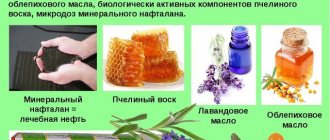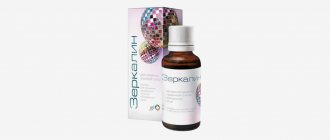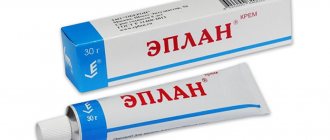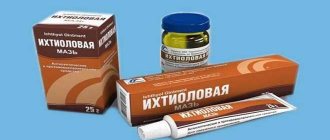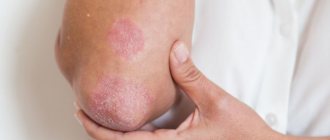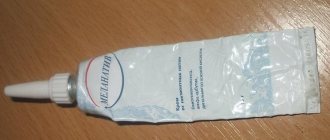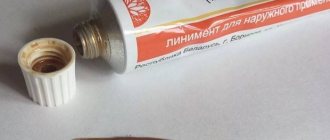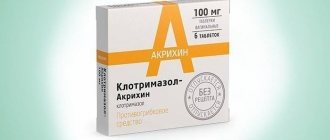Syntomycin ointment contains a broad-spectrum antibiotic; most pathogens of skin diseases and nosocomial infections that cause suppuration of postoperative wounds are sensitive to it.
It is used for burns, trophic ulcers, wounds after cleansing and the beginning of healing, cracked nipples, and pustular rashes. Apply no more than 1 time a day locally or up to 3 times locally, the course is often up to 5 days. Lubricating a burnt or inflamed surface larger than the patient's palm is dangerous due to changes in blood composition.
The drug is contraindicated during pregnancy, renal impairment, anemia, and after radiation treatment or chemotherapy. Children under 3 years of age are prescribed with caution, and infants under 1 month of age are contraindicated. When used correctly, Synthomycin liniment is effective; microbial resistance to it is rare, but it should always be used strictly as prescribed by a doctor.
Synthomycin ointment – emulsion (liniment)
Syntomycin ointment, in fact, is not an ointment. This name is erroneous; in fact, the drug is a liniment, a mixture of oil, liquid and emulsifiers .
Liniment differs from ointment in the composition of the base. Typically, the ointment contains 95-99% petroleum jelly and is a very greasy substance. Liniment contains oil diluted with water with the addition of chemical components.
Since many people are accustomed to calling this drug an ointment, we will also maintain the tradition and not violate generally accepted terminology.
Composition of liniment (ointment)
Synthomycin liniment contains two active ingredients - an antibiotic and an analgesic (syntomycin and novocaine) . The basis of the ointment is natural castor oil , which is not only a formative component, but also exhibits antiseptic and anti-inflammatory properties. Castor oil complements and enhances the effect of the antibiotic.
Syntomycin (chemical term - chloramphenicol
) is similar in structure and action to the antibacterial substance chloramphenicol.
It is syntomycin that provides the effective anti-inflammatory effect of the ointment. It limits the growth of gram-positive microorganisms (streptococci and staphylococci, gonococci and shigella, salmonella and klebsiella)
.
Note: the antibiotic chloramphenicol was invented later than synthomycin and replaced the earlier drug from the treatment of pneumonia, dysentery, gonorrhea, and typhoid. But in external therapy, the use of syntomycin remains popular.
Local use of an antibacterial agent does not lead to its entry into the general bloodstream. Therefore, external treatment with synthomycin does not disturb the intestinal microflora and does not lead to dysbacteriosis.
Synthomycin liniment is a thick gelatinous composition that, when applied to the body, melts and turns into liquid. It is available in three concentrations - 1%, 5%
And
10%
.
Drug interactions
The simultaneous administration of antibiotics in tablets and injections can weaken the effect of Synthomycin liniment (penicillin, cephalosporins), and Nystatin or Levorin (antifungal agents) helps to enhance the effect. The following combinations are prohibited:
- erythromycin,
- lincomycin,
- sulfonamides,
- anticonvulsants,
- alcohol and alcohol tinctures.
All of them increase the toxicity of synthomycin and increase its adverse effects on hematopoiesis and the liver.
What does the instructions for syntomycin ointment say?
The instructions for use of synthomycin ointment provide a list of diseases for which syntomycin is effective. Let's list what synthomycin ointment helps with and what it treats:
- Various infected wounds (injuries and burns, frostbite, accompanied by infection).
- Ulcers, pimples, boils , as well as hidradenitis - the formation of ulcers in the armpits.
Important: synthomycin liniment is not applied to a fresh wound or injury. It is smeared or placed under a bandage several hours or several days after injury.
The ointment is also used in the treatment of gynecological inflammation, hemorrhoids and cracked nipples in nursing women. Or more correctly, it was used in Soviet times, when there were no other treatment options. Today, there are a number of other external medications that are more effective in treatment and safer for an infant. Therefore, synthomycin is not prescribed for the treatment of breasts in a nursing woman .
The instructions also contain the following list of contraindications for the use of synthomycin ointment:
- Sintomycin is contraindicated in case of an allergic reaction to the components of the ointment composition .
- For fungal and viral infections (the antibacterial component reduces local immunity and thereby enhances the effect of pathogens).
- In case of hematopoietic disorders (anemia) , synthomycin aggravates the painful processes.
Synthomycin liniment is used to treat more than forty types of diseases. It is effective against bacteria and mites; it is used to treat extensive inflammation, purulent wounds, and infectious rashes. Let's take a closer look at what inflammations liniment is effective for.
Side effects and contraindications
The ointment is a safe, effective treatment for burns, but it should be used with caution, following these rules:
- Do not apply to the affected skin more often than indicated in the instructions, because it may cause an allergic reaction;
- the duration of treatment is determined by the doctor;
- if you use the ointment for too long, it can lead to complications, so if long-term treatment is necessary, it is better to replace the drug with another remedy, for example, Zinc ointment.
Contraindications for treating burns with ointment:
- kidney dysfunction;
- liver dysfunction;
- eczema;
- severe burns over a large surface of the skin;
- malignant or benign tumors on the skin;
- animal bites;
- intolerance to the components of the drug.
If the product is used incorrectly, adverse reactions may occur such as:
- skin irritation;
- redness;
- itching;
- burning;
- chills;
- increase in body temperature.
The drug should not be used in combination with barbiturates, cytostatics, biphenyl, pyrazolone, or sulfonamides.
If adverse reactions occur, stop drug therapy and contact your doctor to reduce the dose or prescribe another drug.
Use in cosmetics: synthomycin ointment for acne
Synthomycin ointment has found wide use in cosmetology due to its ability to dry inflamed skin. The effect of external use of the antibiotic becomes noticeable after 2-3 days. Thus, after a few days, redness decreases, pimples and ulcers dry out.
If there are only a few pimples, then the ointment is applied pointwise, to each pimple separately. If a large part of the facial skin is covered with acne, the ointment is applied in a continuous layer. For treatment, it is enough to smear your face with ointment 2 times a day (morning and evening) .
For extensive rashes, make a mask of synthomycin, zinc and ichthyol ointment. The components are mixed in equal parts and applied to the face for 10-15, sometimes 20 minutes. After which it is washed off with water. This cosmetic procedure can get rid of severe acne in 10 days.
Note: acne can be treated by simply applying ointment. But when treating a more serious infection - boils - it is necessary to put the ointment under the bandage.
The use of syntomycin ointment for acne on the face in adolescents allows you to survive age-related rashes and do without their extensive manifestation on the face, neck, and neighboring areas of the skin.
And one more thing: synthomycin has a whitening effect. Therefore, it is added to facial skin whitening formulations. They also use synthomycin ointment for age spots.
Sintomycin antibiotic: pharmacology
Synthomycin is an antibiotic chloramphenicol. It is better known under the trade name Levomycetin. These drugs are not considered complete analogues, since synthomycin contains 2 types of molecules (racemic mixture of isomers). According to their chemical structure, they are dextro- and levorotatory, which affects their pharmacological action. That is, Syntomycin is slightly stronger than Levomycetin, but also more toxic, so it is used exclusively externally.
In addition to liniment, it is also available in the form of vaginal suppositories.
Mechanism and spectrum of action of Synthomycin
The antibiotic passes well through the cell membrane of bacteria and binds to their ribosomes. As a result, the microbe cannot use amino acids to form its proteins, which cause inflammation and suppuration. The growth and development of the infectious agent stops.
The advantage of Synthomycin is considered to be a wide spectrum of antibacterial action; the following are sensitive to it:
- staphylococci,
- streptococci,
- coli,
- Proteus,
- peptostreptococci,
- Pseudomonas aeruginosa,
- salmonella,
- shigella,
- yersinia,
- rickettsia,
- a number of chlamydia,
- causative agent of inguinal lymphogranulomatosis.
At the same time, the drug is effective against most nosocomial infections, stops the development of some viruses (for example, herpes), and acts on bacteria that are resistant to penicillin, tetracycline, sulfonamides (for example, Streptocide).
The decrease in sensitivity directly to Synthomycin develops quite slowly, and there is no cross-resistance (when a microbe, under the influence of one antibiotic, becomes resistant to another).
We recommend reading about acne ointments. From the article you will learn about the most effective ointments for acne, how to use hormonal ointments, gels and natural anti-inflammatory ointments for facial skin against acne. And here is more information about the rules for using Levomikol ointment.
Absorption into the blood
The drug has been known for a long time and was used quite widely before the advent of modern antibacterial drugs, which have a greater degree of safety. It remains a popular remedy for self-medication (like the dangerous antibiotic Levomycetin in tablets), mainly due to the low price in pharmacies and the lack of knowledge about the consequences of use.
Synthomycin is well absorbed into the skin and, when applied in large quantities to a large area of skin, penetrates into the bloodstream. This can be considered a negative quality of the drug, since it has a toxic effect on the composition of the blood. Therefore, it is not recommended to use Syntomycin liniment without prescription and uncontrollably.
Properties of the ointment
The main properties of ointment with synthomycin include:
- bacteriostatic (inhibits the growth of bacteria);
- helps clean burn wounds and trophic ulcers;
- accelerates the healing process of skin damage;
- treats inflammation.
Auxiliary components have a calming and softening effect, facilitate the penetration of the antibiotic deep into the skin, and have the ability to slightly reduce pain associated with the inflammatory reaction.
Contraindications for use
The drug is not prescribed for:
- intolerance to chloramphenicol or other components of Synthomycin liniment;
- psoriasis – the appearance of red spots merging with each other;
- fungal infection;
- eczema - inflammation of the skin with rash, burning and itching;
- wounds that do not yet show the first signs of healing;
- infected skin lesions with pus and tissue destruction, severe swelling, pain;
- disruption of the bone marrow (reduced formation of blood cells);
- severe liver and kidney diseases;
- pregnancy;
- congenital deficiency of glucose-6-phosphate dehydrogenase;
- newborns up to 1 month.
Eczema
Use with caution (only under medical supervision) to treat children under 3 years of age.
Possible complications
During the period of use of Synthomycin liniment, the following side effects are possible:
- itching, redness of the skin;
- dryness, swelling at the site of application;
- local or widespread rashes;
- signs of inhibition of blood cell formation (according to tests): decrease in reticulocytes and erythrocytes, leukocytes, granulocytes, platelets, which manifests itself in aplastic anemia (weakness, dizziness, shortness of breath, rapid heartbeat), decreased immunity (frequent respiratory tract diseases, prolonged infections), bleeding.
Any of these symptoms is a reason to immediately stop using the drug. If other unusual changes in general condition or allergic skin reactions occur during treatment, you should immediately consult a doctor. If liniment is used regularly or for more than 7 days, a control blood test is needed.
Hives
After use, the skin area becomes more sensitive to sunlight, which often provokes photodermatosis (redness, irritation, rashes).
If the medication is applied to a burn surface or a large area of the body and the patient drinks an alcoholic drink, the following may occur:
- facial redness,
- hot flashes,
- sweating,
- nausea, vomiting,
- coughing attack,
- frequent and strong heartbeat,
- anxiety, panic,
- headache,
- convulsive syndrome.
This is explained by the fact that when it enters the bloodstream, Syntomycin blocks the action of the enzyme that breaks down alcohol (alcohol dehydrogenase). A toxic intermediate metabolic product accumulates, causing poisoning of the body. A reaction appears similar to the drug disulfiram, used in the treatment of alcoholism (provokes an aversion to alcohol).
Syntomycin ointment in gynecology
In gynecology, syntomycin ointment is used to treat bacterial inflammation of the vagina and external genitalia, and for inflammatory processes on the cervix. For the treatment of vaginitis and vulvitis, syntomycin has a quick and effective effect, limits the spread of inflammation and removes infection.
Important: syntomycin is an antibiotic; it is effective for bacterial infections and is contraindicated for fungal infections. To treat gynecological inflammation with synthomycin ointment, you must be sure that the causative agent of the infection is a bacterium. To do this, you need to take a smear and determine the cause of the infection.
Instructions for use in gynecology recommend introducing the ointment composition into the vagina using tampons. Before this, it is necessary to douche with an antiseptic solution (furatsilin or a decoction of antiseptic herbs - chamomile, sage).
And one more thing: treatment with antibacterial drugs can lead to vaginal candidiasis (thrush) . Therefore, synthomycin ointment should be used when other means of fighting infection are ineffective.
Useful video
Watch this video about the mechanism of action and indications for prescribing Sintomycin ointment:
Similar articles
- Levomekol ointment: features of use, why...
In what situations is it better to use Levomekol ointment. What does the drug help with in dentistry, gynecology, urology. Instructions for use Levomikol. Can it be used for children, pregnancy and breastfeeding? Contraindications to the drug. Read more - Acne ointment: which will help with inflammation,…
List of the best ointments for acne. Which ones really help for healing, for subcutaneous acne, inflammation. What hormonal ointment can I use? What gels will be an alternative? Read more
- Sinaflan ointment: what it helps with, features...
What is Sinaflan ointment used for and how exactly? Is it a hormonal drug or not, what side effects may it cause? Analogues of the drug, what is the difference between liniment and ointment. How to use in cosmetology, against herpes. Is it possible for pregnant, lactating, children and the elderly. Read more
- Panthenol: composition of the drug, what to use it for...
The main composition of the drug Panthenol. How to use it correctly and for what purposes: for wounds, for allergies, bedsores, for hands, for burns. How and how much to use for children. Is it possible during pregnancy? Main contraindications and possible complications. Read more
- Ointment for wound healing: which one is suitable for open...
How is ointment used to heal wounds? The best ointment for purulent and open wounds, for skin regeneration. Which one should you choose for children during pregnancy? What to use for cracks. Effective ointments with antibiotics. Which is better - cream or gel? Read more
- Scar ointment: which one is suitable for healing...
What is the most effective ointment for scars that will help better with scars. What drug promotes resorption and healing - Heparin ointment, Ichthyol, Anti-scar, Zinc, Solcoseryl and others. Read more
Syntomycin ointment for burns
As a rule, extensive burns are accompanied by infection of the wound surface. Any burns violate the integrity of human skin and reduce the body’s defenses against external infections. Therefore, burn wounds often become inflamed.
Syntomycin ointment is used for burns of various sizes and degrees . For large burn surfaces, syntomycin is applied to the surface without waiting for redness, inflammation, or pus to appear.
The use of synthomycin allows for the timely removal of necrotic tissue, the retention of which in the wound causes the formation of scars. As a result, it affects the epithelization of the wound without the formation of scars.
Price for the drug
Synthomycin liniment 10% 25g can be bought at a price of 34-36 rubles, and produced by Nizhpharm for 65 rubles. Many patients note the effectiveness of the latter ointment. Suppositories of 250 mg, 10 pieces per package, cost about 48 rubles, they are bought with a doctor’s prescription (liniment is an over-the-counter drug).
We recommend reading about what ointments are used to heal wounds. From the article you will learn about the indications for the use of regenerating ointments, the best ointments for open and weeping wounds, with antibiotics. And here is more information about why and how Panthenol is used.
Synthomycin ointment (liniment) is used for burns, cracked nipples, pustular rashes, infectious skin diseases, to accelerate wound healing and prevent infection. When applied in large quantities it is toxic; blood composition needs to be monitored during treatment.
Synthomycin ointment for cracks during breastfeeding
There are conflicting recommendations from doctors and pharmacists regarding the possibility of using ointment during breastfeeding. On the one hand, an ointment with an antibacterial component is not recommended for use by nursing women. On the other hand, in the list of diseases for which the syntomycin composition is used, there is the following recommendation - syntomycin liniment is used to treat cracked nipples in women in labor. Thus, the instructions allow the use of ointment for breast treatment.
Important: if an antibacterial agent is still used by a nursing woman, then it is necessary to wash the nipples before feeding and prevent liniment from getting into the baby’s mouth.
Precautionary measures
When treating with Synthomycin liniment, it is important to be careful; the following should not be allowed:
- contact with eyes;
- uncontrolled and unsystematic use (from case to case);
- self-medication;
- use for children without prescription and medical supervision;
- use immediately after a course of chemotherapy or radiation;
- simultaneous application with cosmetics;
- lubricating contaminated skin.
Syntomycin ointment: instructions for children
The composition with synthomycin is prohibited for use in newborns of the 1st month of life . In some cases, when using synthomycin in young children, symptoms of poisoning are observed - nausea, flatulence, heart rhythm disturbances. The listed symptoms may be accompanied by darkening of the facial skin (the appearance of a gray-blue tint).
For children under 3 years of age, ointment is prescribed with caution and only if necessary.
Note: the syntomycin composition is used for the external treatment of vulvitis (inflammation of the external genitalia) in girls of preschool and school age.
Prevalence of atopic dermatitis in children
It is safe to say that this disease can occur in any country, in both males and females. Dermatitis occurs in different age categories. The prevalence of AD is higher in residents of economically developed countries, which may be due to the urban lifestyle of this population. According to the protocol for the treatment of AD in children, the prevalence of this pathology in the Russian Federation ranges from 6 to 15% according to ISSAC. ISAAC is a standardized epidemiological study - the International Study of Asthma and Allergy in Childhood. Repeated studies within the framework of this program show a significant increase in the prevalence of AD in children of the Russian Federation.
Research shows a significant increase in the prevalence of atopic dermatitis in children in the Russian Federation.
Also, the expert committee on asthma and allergy of the WHO European Bureau developed and approved another program - GA2LEN. GA2LEN (Global Allergy and Asthma European Network) studied the incidence of allergic pathology among adolescents aged 15 to 18 years. According to the study, the presence of symptoms of AD occurred in 33% of adolescents, the prevalence of AD according to questionnaires was 10%, and a confirmed diagnosis was found in 7% of adolescents. Girls have 1.5 times more than boys.
Syntomycin ointment for hemorrhoids
Antibacterial treatment is necessary when there is a bacterial infection. With hemorrhoids, severe inflammation and periodic bleeding occur in 3
and
4 stages of the disease
. Syntomycin ointment helps stop the inflammatory process and remove swelling. As a result, it reduces the sensation of pain.
Local application of a topical antibiotic is used as an adjunct to primary therapy. For a complete cure, general therapy is necessary - establishing venous blood flow, eliminating congestion in the veins of the rectum.
Features of application
The low price and availability of syntomycin ointment make it a popular treatment for any inflammation. Therefore, it is important to know some of the features of its use.
- The frequency of treatment (applying ointment) is determined by the degree of inflammation and the concentration of the ointment composition . So, for extensive burns, syntomycin 5% ointment (or liniment) is applied 6 times a day. And the 10% composition is only 3 times.
- If the ointment is applied to large areas of the body, but do not drink alcohol . Otherwise, heart rhythm disturbances (tachycardia) and seizures are possible.
The effect of the ointment or liniment appears on the 2-3rd day of use. If during this time you do not feel better, look for another treatment. This ointment is not suitable for you.
Reviews
Dina, Zaraysk
When I was 12 years old, the first acne appeared, and my mother gave me syntomycin ointment. And she said “here’s a good remedy for acne.” Thanks to this remedy, I avoided many teenage torments associated with my appearance.
Ekaterina, Zhigulevsk For me, too, syntomycin ointment was a discovery. The pimples replaced each other constantly. Now there are much fewer of them, one might say almost none.
Tamara, Chelyabinsk The acne was so bad that they recommended a blood transfusion. I had almost decided to take this extreme measure, but then someone advised me to use syntomycin ointment as a miracle remedy. I studied the composition and decided to try it. I only applied it at night. And lo and behold! It helped me.
Gosha, Zapolyarny When I was a child, I was treated for a burn with syntomycin ointment. I was badly scalded with boiling water, the doctor told me to cover the wound with gauze and synthomycin. There were no other means then. That's how we were saved. It has healed without scars, only a small spot remains on the skin, it is a different shade of color in the place where there once was a burn.
